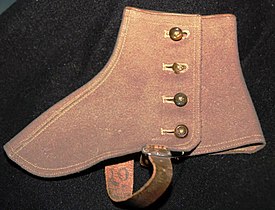Spats (footwear)

Spats (originally a contraction of spatterdashes) are a type of classic footwear accessory covering the instep and ankle. Spats were primarily worn in the late 19th and early 20th centuries.
As items of uniform
Spats are still used as a traditional accessory in many marching band uniforms in the United States.
French infantry wore white spats for parade and off duty wear until 1903. Italian soldiers wore a light tan version until 1910 and the Japanese Army wore long white spats or gaiters during the Russo-Japanese War of 1905.
Spats continue as a distinctive feature of the Scottish dress of Highland pipe bands, whether civilian or military. The modern Royal Regiment of Scotland, into which all Scottish line infantry regiments were amalgamated in 2006, retain white spats as part of their uniform. Prior to that date most Scottish infantry units in the British Army wore spats. For Highland regiments in kilts spats reached halfway up the calf. For Lowland regiments in trews spats were visible only over the boots.
Most regiments of the modern Indian and Pakistani Armies wear long white spats into which trousers are tucked, as part of their parade dress. Other full dress uniforms which still include spats are those of the Finnish Army, Portuguese Republican National Guard, the Carabiniers of Monaco, the Egyptian Military Police and the Italian Military Academy of Modena. In the Finnish Navy, spats are part of the winter uniform. The U.S. Navy Honor Guard and Rifle Guard still wear them while performing ceremonies.
For safety
Spats are still used today in certain industries for safety reasons. In foundries molten metal pourers often wear leather spats to keep splashes of molten metal from burning their feet. Even a small splash that lodges in a shoe or between the shoe and ankle could cause a severe burn. Many welders also wear leather spats for protection from sparks and metal splash. Some chainsaw operators wear protective leather spats, often combined with chainsaw boots to prevent injury from accidental chainsaw contact with the foot or ankle.
Symbolic usage to represent wealth
The wearing of spats is often used as symbolic shorthand to represent wealth, eccentricity or both. Fictional characters such as Agatha Christie's Hercule Poirot, P. G. Wodehouse's Bertie Wooster, Walt Disney's Scrooge McDuck, Jean de Brunhoff 's Babar the Elephant, Jiggs from the comic strip Jiggs and Maggie, the iconic man from the Monopoly board game – Rich Uncle Pennybags, the Sixth Doctor from Doctor Who and Bustopher Jones from the Andrew Lloyd Webber musical Cats, among others, have been depicted as wearing spats. In Some Like It Hot, the mob boss is called "Spats" Colombo, because he wears them to look more like a gentleman. In some cases, these depictions occur long after spats ceased to be a normal part of everyday menswear: The Joker from Batman, for instance, is drawn wearing spats along with a suit with tails. Similarly, Irving Berlin's song "Puttin' on the Ritz" mentions spats along with a variety of other elements of formal clothing that were common when it was written.
Other uses
- In Japan, the term "spats" refers to leggings.
- In American football, the act of taping the outside of one's cleats using athletic tape is known as "spatting."
See also
References
This article needs additional citations for verification. (July 2008) |
